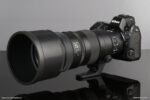Image Quality
Here’s the meat of this review: image quality. There’s been a lot of buzz around the image quality for this lens, and I found out very quickly it’s for good reason. In short, the quality of the XF 90mm is absolutely superb.
Sharpness
The XF 90mm f/2 R is a very sharp lens. Right from f/2 over almost the entire frame, the lens is capable of tack sharp images. The last bit of the edges and corners show a little softening at further focus distances, but are still good. Stopping down to f/4 yields razor sharp images across the entire image. Simply put, pick the aperture for the depth of field you want and don’t worry about anything else: you’ll get sharp images. Of course, stopping down to f/16 or so will show softening due to diffraction, but that’s a physics limitation, not a lens limitation.

Bokeh
Critical for portrait lenses is the quality of the out of focus areas. While the XF 56mm f/1.2 showed good bokeh with a bit of character (and some bright outlining of specular highlights), the XF 90mm f/2 has nearly technically perfect bokeh. Out of focus areas are smooth and even and specular highlights are perfectly evenly illuminated, with a very slight falloff at the edge which just melts the blur disc into the other colors. There is no outlining, no double edges, no bokeh fringing: it’s just smooth and even. Because the 90mm f/2 doesn’t use aspherical elements, there is also no onion ring centers to highlights. What’s amazing to me, and what you’ll be able to notice in the image samples, is that the bokeh retains its smoothness at all focus distances, in both the foreground and the background.

Color, Contrast and Chromatic Aberration
The Fuji 90mm keeps high image contrast and rich, vibrant color throughout the aperture range, with no apparent loss of contrast at the widest apertures. This results in images with real presence, and a fair bit of what many call ‘3D pop.’ Indeed, the high image contrast and sharpness combined with the smooth bokeh can make distant subjects really pop out of the frame, such as in the shot below.

Distortion, Flare and Vignetting
The hits keep coming in these departments as well. I’m sorry for such short descriptions here, but there’s really nothing to describe. The lens has virtually no distortion, which isn’t surprising, as medium telephotos generally don’t have a problem with distortion. However, the lens also controls vignetting very well. There is some slight darkening at the corners at f/2, but even this isn’t particularly field relevant. Stopped down it’s essentially absent. Against bright light, again, I didn’t see much in the way of flare. I have seen a few other tests where the shooter was able to induce rather nasty flares with small apertures, but I never encountered it in my shooting, perhaps because of the narrow field of view and the fact I always used the hood. In any case, I don’t think it’s much to worry about.
The Fuji XF 90mm f/2 is nearly flawless optically. That’s not to say that there aren’t better lenses in the world, but it is truly one of the finest lenses I’ve ever used, with no real weaknesses and a very strong showing in all departments. Fuji’s outdone themselves here.






Leave a Reply